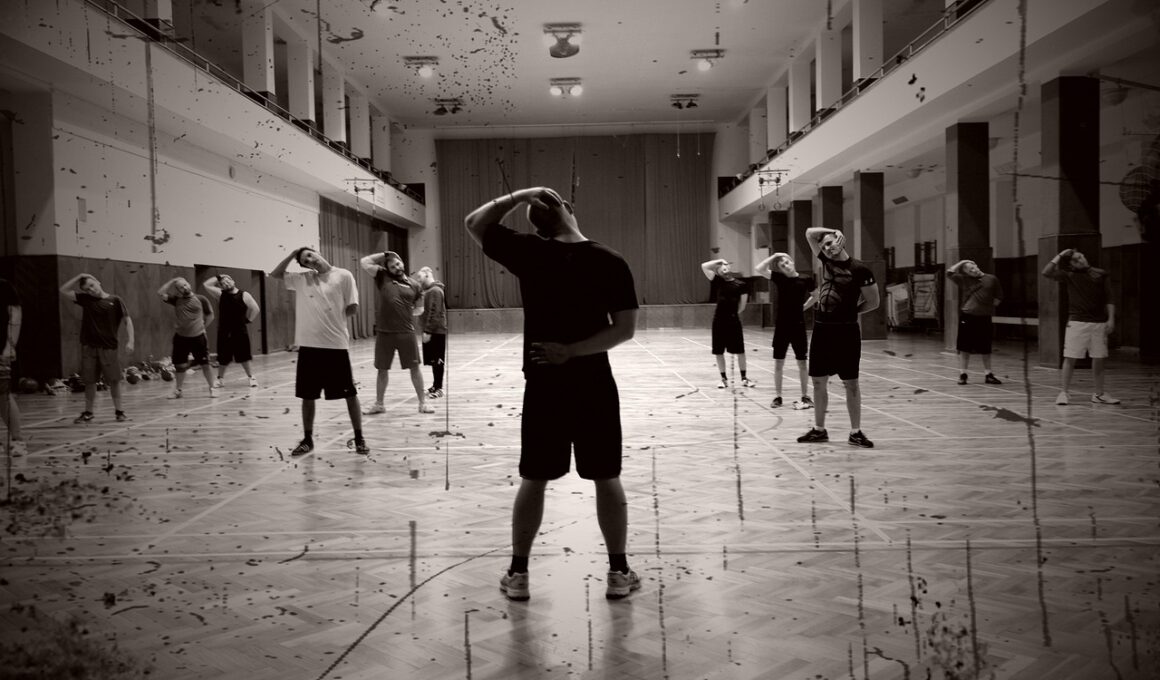Dynamic Warm-Ups for Week 21 Workout Plans
As we enter week 21 of our workout plans, focusing on mobility and recovery is crucial. Dynamic warm-ups are essential for preparing muscles and joints for intense workouts. They can increase blood flow and flexibility, enhancing performance and reducing injury risks. Integrating these warm-ups into your routine can significantly benefit overall physical fitness. Consider beginning with arm circles, which help loosen the upper body. You might also include leg swings, promoting hip mobility and flexibility. Another great exercise is torso twists, engaging the core and improving spinal mobility. Additional dynamic stretches can improve range of motion and prevent strains. Always ensure exercises are performed with controlled movements and proper form. Remember to customize warm-ups based on your fitness level. They should feel energizing rather than exhausting. Over time, aim to increase the complexity of your warm-ups, incorporating movements that mimic your workout activities. This prepares your body effectively for both strength training and cardio sessions. Always listen to your body during warm-ups to prevent overstretching or injuries. Planning your warm-ups can make a big difference in achieving fitness goals and maintaining overall health.
Continuing with effective warm-up strategies is crucial for any workout. Ensure you’re involving the entire body in your routine. For instance, include lunges and high knees as they activate multiple muscle groups. High knees promote cardiovascular health while also warming up leg muscles. Lunges are excellent for building mobility, particularly in the hips and knees. Furthermore, remember to incorporate dynamic stretches that engage your arms, such as arm swings. These increase circulation and improve joint movement as well. Adding the inchworm exercise can also enhance your core stability while bringing additional flexibility into your legs, back, and arms. Always prioritize executing warm-ups with a focus on good form. Misalignment can lead to injuries, especially when transitioning into heavier workouts. Plan to dedicate at least 10 to 15 minutes to your warm-up routines. Start with low-intensity movements and increase gradually, allowing your body to adapt. Consider engaging in partner-assisted stretches with a workout buddy to maximize effectiveness. Dynamic warm-ups keep your body prepared and responsive, reducing the likelihood of post-workout soreness. Adherence to these principles pays dividends in improving your overall workout experience.
In addition to traditional warm-ups, exploring alternative routines can be beneficial. Many athletes find yoga-inspired movements serve as excellent dynamic warm-ups. Yoga poses like the Downward Dog transition into positions promoting flexibility and strength. These poses also encourage controlled breathing, enhancing mental focus before workouts. Consider practicing the Sun Salutation sequence to prepare the body through various motions. This combination of stretches can engage your muscles effectively while calming the mind. Incorporating movements like dynamic side lunges can further enhance lateral mobility, critical for many sports. Keeping a routine varied helps maintain interest and motivation. You might invite new workouts, such as mobility drills focusing on hips and shoulders, into your preparations. Remember, it’s essential to stay mindful of your body’s responses. Listen carefully and connect your warm-ups with your overall training goals. An optimal warm-up should leave you feeling energized, not fatigued, fostering an environment for effective workouts. Innovation in warm-up techniques can revitalize your routine, inspiring ongoing commitment. Continuing to explore and adapt these warm-up methodologies can contribute significantly to your long-term success.
Another critical component of warm-ups includes utilizing resistance bands or stability balls. Integrating these tools into your dynamic warm-up routine can elevate the benefits. Resistance bands can be particularly effective in activating different muscle groups while maximizing range and strength. Movements like banded walks target the hips and glutes, ensuring these areas are prepared for the workout ahead. Furthermore, stability balls enable dynamic movements that engage your core while enhancing coordination. Consider performing exercises alternating between the band and ball to further challenge and warm your body. Typically, this technique encourages muscle readiness before any vigorous activity. Similarly, exercises focusing on ankle mobility are worth including. Simple ankle circles can enhance stability during workouts high-impact or lower-intensity. Ankle readiness can hugely affect performance, supporting effective weight distribution and movement quality. Retaining individual focus on each joint can improve joint health over time. Hence, it’s essential to adopt diverse warm-up modalities. Becoming creative in warm-up approaches can lead to discovering what works best for you personally. Aim to standardize effective practices that resonate with your fitness journey and personal preferences.
Lastly, effective warm-ups should not be overlooked, especially in mobility-focused training regimens like week 21’s theme. Active recovery techniques need special attention as well. Understanding and integrating cooldown practices post-workout contributes significantly to overall muscle recovery and flexibility. This can include gentle stretches focusing on muscles that were worked during the session. The importance of hydration should also not be underrated in this context. Be sure to hydrate adequately before and after workouts. Hydration supports joint function and overall muscle performance during all types of activities. Also, incorporating foam rolling in recovery sessions reduces muscle stiffness considerably. This aids in enhancing your overall recovery process. Explore different foam rolling techniques targeting specific areas for maximum effectiveness. Always consider the intensity of workouts when deciding on recovery practices. Balancing hard, high-intensity workouts with planned recovery will improve your performance over time. Deliberate recovery protocols should align with your individual comfort levels and intensity of exercises. Gradually increase the complexity of your recovery protocols. Tailoring these plans to fit individual needs promotes long-lasting fitness benefits.
Collaborative exercises with a partner can significantly increase the engagement of your warm-ups. For instance, partner stretches elevate the intensity of dynamic warm-ups while fostering camaraderie. Moreover, engaging in partner activities motivates consistency and brings an engaging twist. Consider incorporating partner games focusing on mobility. These can include dynamic movements with resistance bands that require teamwork. This investment of energy results in mutual benefits, enhancing workout excitement. Each partner can provide feedback on form and technique. This mutual support encourages proper use of practices and techniques among participants. It’s critical to stay attentive to how each partner feels about their movements. Communication during workouts enhances group motivation and enjoyment. When the warm-up transitions smoothly into the workout phase, the entire experience feels gratifying. Focusing on shared workout goals can deepen bonds while propelling fitness accomplishments. Spark creativity by trying varied exercises to keep routines fresh. Friendships can flourish through shared experiences in fitness. Inviting social elements enhances workout enjoyment while promoting healthful outcomes. Partner workouts are an innovative approach to reinvigorating traditional workout methods while fostering a strong commitment to fitness.
In conclusion, embracing dynamic warm-ups as part of your exercise regimen during week 21 is integral to improving performance. The mobility focus enhances overall fitness and prevents injuries. Regularly add variety to warm-ups, exploring different movements, tools, and partner tasks. It’s essential to create routines that suit your specific fitness level while remaining manageable to follow consistently. Prioritize investing time in warm-ups; doing so pays dividends in both the short and long term. Explore and refine warm-up techniques tailored to your personal goals. The journey toward enhanced mobility and overall fitness is a continuous one, requiring adaptability and creativity. Challenge yourself to embrace new methods and experiences at every stage of the process. The more versatile and engaging your warm-ups become, the more enjoyable your entire workout will be. Promoting a culture of experimentation conducted responsibly positively impacts workout enthusiasm. Take this dedication forward as you strive for fitness excellence in every aspect of your journey. With responsible practices in place, achieving lasting success and improved performance becomes more attainable.


